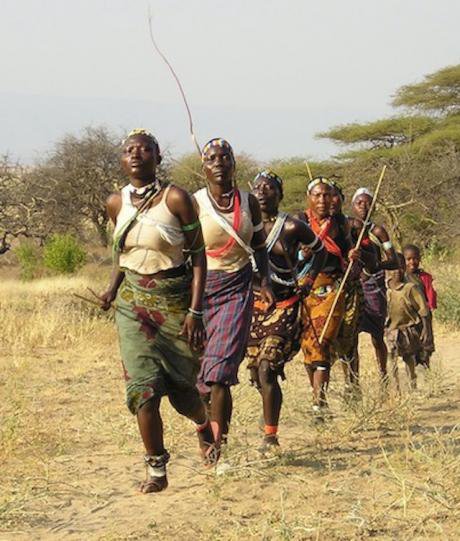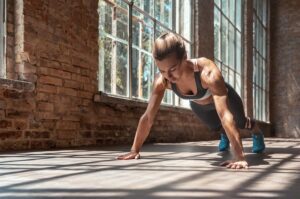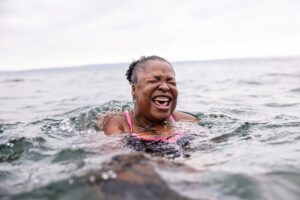
Nghiên cứu đã chỉ ra rằng những người vẫn sống theo lối sống săn bắt/hái lượm của tổ tiên không gặp phải vô số bệnh tật liên quan đến rối loạn chức năng sinh sản hoặc mãn kinh ở các nước phát triển, phần lớn có thể là do quá trình trao đổi chất tương đối khỏe mạnh. Khi nghĩ về những gì sẽ hỗ trợ hormone, hệ vi sinh vật và quá trình trao đổi chất của chúng ta, ở bất kỳ độ tuổi hoặc giai đoạn nào, chúng ta có thể cân nhắc đến sự khác biệt trong chế độ ăn uống và lối sống của mình. Vì vậy, mặc dù chúng ta có thể không muốn "vứt bỏ cả đứa bé lẫn nước tắm" và quay lại cuộc sống mà không có nhiều tiến bộ công nghệ tuyệt vời như vậy, chúng ta vẫn có thể tìm hiểu cách tổ tiên loài người và người vượn của chúng ta sống để tìm manh mối về cách ngăn ngừa một số tình trạng thoái hóa đang gia tăng ở con người hiện đại. Đây là một vấn đề lớn, vì vậy hãy kiên nhẫn và bắt đầu trò chơi!

Con người sống theo tổ tiên
Có những nhóm người truyền thống còn sót lại trên trái đất, sống và ăn như họ đã làm trong hàng ngàn năm. Mặc dù họ không được tiếp cận với những tiến bộ hiện đại và dịch vụ chăm sóc sức khỏe của chúng ta trong những tình huống cấp bách hơn, nhưng họ có rất ít bệnh thoái hóa hoặc nhu cầu dùng thuốc dược phẩm dài hạn. Các nghiên cứu đã chỉ ra rằng họ có hệ vi sinh vật đa dạng và khỏe mạnh cùng hệ thống sinh sản hoạt động tốt. Họ dường như đạt được điều này bằng cách:
- tiêu thụ chế độ ăn giàu dinh dưỡng, tập trung vào thực phẩm từ động vật
- trải nghiệm sự kết nối sâu sắc với trái đất và với nhau
- có mạng lưới xã hội và gia đình hỗ trợ
- ít hoặc không tiếp xúc với EMF, hóa chất độc hại/mãi mãi hoặc ô nhiễm không khí
- duy trì hoạt động trong suốt cuộc đời với mức độ căng thẳng tổng thể thấp hơn
- tiếp xúc hàng ngày với ánh sáng tự nhiên từ mặt trời (có ánh lửa vào ban đêm)
- tiếp xúc thường xuyên với lạnh hoặc nóng
Các nghiên cứu khoa học đã chứng minh rằng những thói quen sống này hỗ trợ nhịp sinh học của con người, quá trình trao đổi chất lành mạnh, chức năng sinh sản và nội tiết tố cân bằng, giấc ngủ ngon, tiềm năng oxy hóa khử, kiểm soát căng thẳng và hormone “tạo cảm giác thoải mái” tự nhiên.
Phần 2 – Tập thể dục, Thực hành nhiệt, EMF và ô nhiễm, và căng thẳng
Bài tập
Chúng ta đang ở thời điểm có thể nói rằng một số loại bài tập trong ngày là cần thiết…ở mọi lứa tuổi. Trên thực tế, hoạt động nhất quán trong suốt cả ngày hiệu quả hơn là ngồi cả ngày rồi đến phòng tập trong một giờ. Các nghiên cứu cho thấy hoạt động thường xuyên và một số bài tập cường độ cao hơn hỗ trợ giảm các vấn đề về sinh sản và nội tiết tố, ví dụ, các biểu hiện mãn kinh như nhiệt độ dao động và tâm trạng thất thường, cũng như sự cân bằng của hệ vi sinh vật và nội tiết tố. Cơ bắp hiện đang được coi là cơ quan trường thọ và có liên quan đến sức khỏe trao đổi chất, tim và xương. Ngoài ra, tập thể dục có thể có xu hướng hỗ trợ các chất dẫn truyền thần kinh làm dịu. Ba thay đổi sinh lý sau thời kỳ mãn kinh là mất cơ xương và mật độ xương và tăng mô mỡ, đặc biệt là mỡ nội tạng không lành mạnh. Có một loại mỡ dưới da, lớp mỡ đầu tiên dưới da, có lợi cho quá trình trao đổi chất. Lớp mỡ dưới da nông này có hoạt động trao đổi chất, tiết ra các hormone có lợi. Lớp mỡ dưới da sâu hơn thường không có lợi cho quá trình trao đổi chất và mỡ nội tạng, đặc biệt là khi phát triển bên trong các cơ quan, rất không lành mạnh.
Con người truyền thống vẫn tiếp tục hoạt động, tăng và duy trì khối lượng cơ nạc đáng kể. Vì vậy, ngay cả khi họ có mô mỡ dưới da, một số hoặc hầu hết trong số đó sẽ là mỡ nâu/be nông khỏe mạnh, và do đó họ vẫn khỏe mạnh về mặt trao đổi chất - điều này đã được chứng minh là lành mạnh hơn so với việc có cơ bắp kém với ít hoặc không có mỡ cơ thể. Một chiến lược phòng ngừa là phụ nữ tập trung vào việc xây dựng và duy trì sức mạnh cơ bắp. Có đủ mọi cách để đạt được điều này. Bạn bắt đầu càng sớm thì càng tốt; tuy nhiên, bất kỳ độ tuổi nào cũng là độ tuổi hoàn hảo để bắt đầu tập luyện sức bền, v.v. và để thấy được những lợi ích. Nghiên cứu đã chỉ ra rằng tập luyện sức bền (nâng tạ) và nhảy là chìa khóa cho sức khỏe xương sau thời kỳ mãn kinh.

Một trọng tâm khác có thể là các bài tập làm giảm cortisol và các hormone gây căng thẳng khác. Chỉ cần đi bộ 20-30 phút là đủ để làm giảm đáng kể mức cortisol. Con người truyền thống có xu hướng đi bộ rất nhiều. Đi bộ trung bình 10.000-12.000 bước mỗi ngày, trung bình, có liên quan đến cân nặng khỏe mạnh và chức năng tim mạch. Pilates, yoga nhẹ nhàng, khí công, thái cực quyền hoặc các chuyển động nhẹ nhàng khác cũng có thể rất hữu ích trong việc giảm căng thẳng. Huấn luyện ngắt quãng cường độ cao (HIIT) đã được chứng minh là một phương pháp hỗ trợ lão hóa lành mạnh mạnh mẽ cho tim và não và lượng bài tập tim mạch được nhắm mục tiêu được biết là hỗ trợ sửa chữa và phát triển các tế bào não, mô tim và chức năng phổi (VO2 max). Chạy nước rút, đối với những người có thể xử lý được, cũng cho thấy lợi ích đặc biệt là hỗ trợ giảm mỡ nội tạng. Một chế độ vận động bao gồm nhiều lần đi bộ với lượng bài tập tim mạch và sức mạnh phù hợp với lứa tuổi, kết hợp với các bài tập thăng bằng và yoga, có thể chỉ có tác dụng. Thêm một số bài tập HIIT nếu thích hợp. Khi bạn đang làm điều đó, hãy tập thể dục ngoài trời và dành thời gian đi chân trần trên cỏ hoặc cát, hoặc bơi ở biển/hồ/sông, để tận hưởng lợi ích của ánh sáng tự nhiên và được kết nối với trái đất. "Tắm rừng" - ở hoặc đi bộ trong bụi rậm hoặc rừng đã được chứng minh là hỗ trợ mức độ căng thẳng lành mạnh và hormone sinh sản.
Trí tuệ tập trung cho:
- Thanh thiếu niên và tuổi dậy thì: Bất kỳ hoạt động nào mà họ thích tham gia! Không phải ai cũng siêu khỏe mạnh, nhưng tất cả chúng ta đều có thể tìm thấy một số loại "trò chơi" hoặc chế độ tập thể dục mà chúng ta thích làm.
- Tuổi sinh sản: Tập thể dục để tạo sức mạnh, sự dẻo dai, khối lượng cơ nạc và hormone cân bằng. Các bài tập HIIT đã được chứng minh là hỗ trợ tim và mạch máu liên quan đến tình trạng cứng tim mạch do tuổi tác.
- Khả năng sinh sản: Tập trung nhiều hơn vào các bài tập giảm căng thẳng nhưng khá giống với thói quen bình thường nếu khỏe mạnh.
- Mang thai: Nghiên cứu cho thấy phụ nữ mang thai vẫn hoạt động ít gặp vấn đề hơn khi mang thai và sinh nở. Tất nhiên là tránh các môn thể thao đối kháng và các hoạt động mạnh hoặc căng thẳng!
- Thời kỳ mãn kinh: Tập trung vào an toàn duy trì hoặc xây dựng khối lượng cơ cho mật độ xương và sức mạnh. Tham gia các hoạt động vui vẻ và thú vị để giúp giảm căng thẳng. Đi bộ ngắn sau bữa ăn có thể hỗ trợ cân nặng khỏe mạnh. Đừng sợ tập thể dục cường độ cao, thời gian ngắn và tập tạ, vì những lợi ích đã được nghiên cứu kỹ lưỡng, nhưng hãy thực hiện dưới sự giám sát nếu đã lớn tuổi.
Thực hành nhiệt

Con người truyền thống thường xuyên tiếp xúc với nhiệt độ cực nóng và cực lạnh. Chúng ta đã tiến hóa các protein "sốc" được giải phóng để phản ứng với căng thẳng của nhiệt độ cực nóng hoặc cực lạnh, kích hoạt một loạt các quá trình cuối cùng có lợi. Điều này được gọi là căng thẳng kích thích tố, hay "những gì không giết chết bạn sẽ khiến bạn mạnh mẽ hơn". Một cơ quan nghiên cứu đang phát triển đang tìm ra mối liên hệ giữa việc tiếp xúc với nhiệt độ cực lạnh hoặc cực nóng và chức năng sinh sản khỏe mạnh hơn và thời kỳ mãn kinh suôn sẻ hơn. Nghiên cứu cho chúng ta biết rằng 3 lần ngâm mình trong nước lạnh riêng biệt, tổng cộng 11 phút mỗi tuần và 3 lần xông hơi riêng biệt, tổng cộng khoảng 60 phút mỗi tuần là đủ để thấy được lợi ích trong quá trình trao đổi chất và thành phần chất béo.
Có vẻ như việc vào phòng xông hơi khi bạn đang bị bốc hỏa là điều trái ngược với trực giác, nhưng nhiều nghiên cứu cho thấy phòng xông hơi có lợi trong thời kỳ tiền mãn kinh. Phòng xông hơi khô và/hoặc hồng ngoại đã được chứng minh là hỗ trợ kiểm soát nhiệt độ bên trong và mồ hôi, giấc ngủ ngon, sự thoải mái cho tim mạch và khớp, ham muốn tình dục và cân nặng khỏe mạnh, kiểm soát căng thẳng và tâm trạng cân bằng ở phụ nữ mãn kinh. Phòng xông hơi thường được coi là cao hơn 75°C (khoảng 170°F). Phòng xông hơi hơi nước dường như không mang lại những lợi ích tương tự, phòng xông hơi hồng ngoại cũng vậy. Tiếp xúc với tia hồng ngoại có lợi, bạn chỉ cần tách việc tiếp xúc với ánh sáng hồng ngoại có lợi khỏi các buổi xông hơi rất nóng của mình (trừ khi ánh sáng hồng ngoại của bạn có thể chịu được nhiệt!).

Ở đầu lạnh của quang phổ, bằng chứng mới nổi cho thấy rằng việc ngâm mình trong nước lạnh thường xuyên, hay liệu pháp đông lạnh, có thể hỗ trợ chức năng sinh sản và hormone, kiểm soát căng thẳng và tâm trạng, giúp khớp thoải mái, lưu thông máu và huyết áp, đồng thời tăng lượng mỡ “be” lành mạnh (tách ty thể trong mô mỡ trắng) và giảm sự hình thành mỡ nội tạng gây hại xung quanh các cơ quan nội tạng. Tiếp xúc với nước lạnh thậm chí còn được chứng minh là hỗ trợ cảm giác có động lực bằng cách tăng mức dopamine trong tối đa 6 giờ. Những gì cấu thành nên nước “lạnh” thường được hiểu là nhiệt độ dưới 15,5°C (khoảng 60°F), thậm chí thấp tới 2-3°C, dẫn đến nhiều phản ứng căng thẳng kích thích tố trong cơ thể.
Có bằng chứng mạnh mẽ cho thấy phụ nữ không trải nghiệm được những lợi ích mà nam giới có được ở nhiệt độ dưới khoảng 11-13°C (51,8-55,4°F) vì phản ứng tiêu cực của hệ thần kinh giao cảm đối với nước cực lạnh quá mạnh ở phụ nữ. Ngoài ra, còn có những thay đổi nội tiết tố hàng tháng trong những năm sinh sản có nghĩa là việc ngâm mình trong nước lạnh có thể bị chống chỉ định vào một số thời điểm nhất định trong chu kỳ của phụ nữ (xem Trí tuệ tập trung cho: *Tuổi sinh sản). Đối với những phụ nữ muốn tận hưởng những lợi ích của việc tiếp xúc với nước lạnh, chỉ cần ngâm mình nhanh trong nước biển hoặc nước tắm ở nhiệt độ khoảng 11-16°C (51,8-60,8°F) là đủ. Có vẻ như Jack đã có cái nhìn sâu sắc về mặt khoa học khi đưa cho Rose một mảnh khung cửa để nằm vào cuối phim Titanic!
Một lưu ý là vì những phương pháp này giải phóng hormone gây căng thẳng và kích hoạt phản ứng miễn dịch, nên bạn nên tham khảo ý kiến bác sĩ trước khi bắt đầu để biết liệu liệu pháp nhiệt có phù hợp với mình không. Ngâm mình trong nước lạnh tốt nhất vào đầu ngày. Sau 4-5 giờ chiều, cơ thể bạn muốn hạ nhiệt độ để ngủ, vì vậy bạn sẽ khó "làm nóng" và phục hồi sau khi tiếp xúc với nước lạnh hơn. Nhiều người tắm nước lạnh trong 30 giây đến 2 phút sau khi tắm, nhưng mặc dù có lợi, nhưng điều này dường như không có cùng một nhóm tác dụng, mặc dù nó có thể hoàn toàn tốt cho phụ nữ. Xông hơi có vẻ có lợi nhất khi tiếp xúc vào cuối ngày và nhiệt có vẻ có lợi hơn lạnh đối với hầu hết phụ nữ. Trong mọi trường hợp, không có phương pháp nào trong số này được xem xét thiết yếu, không giống như các phương pháp khác được nêu trong các bài viết này; tuy nhiên, chúng có thể thú vị và có lợi cho sức khỏe nếu được sử dụng đúng cách. Hãy luôn lắng nghe cơ thể của bạn.

Trí tuệ tập trung cho:
- Tuổi vị thành niên và tuổi dậy thì: Xông hơi và ngâm mình trong nước lạnh có thể không phải là sở thích thường thấy của thanh thiếu niên nhưng đôi khi các em có thể thử bơi trong nước lạnh.
- *Tuổi sinh sản: Tránh tắm nước lạnh trong thời kỳ rụng trứng và ngay trước và trong kỳ kinh nguyệt. Xông hơi trong thời gian này sẽ rất tốt.
- Khả năng sinh sản: Một lần nữa, tập trung nhiều hơn vào việc giải tỏa căng thẳng, do đó hãy hạn chế hoặc tránh ngâm mình trong nước lạnh; có thể là nhiều phòng xông hơi hơn, ở nhiệt độ thấp hơn nếu bạn thích. FYI, khả năng sinh sản của nam giới được cải thiện nhiều hơn nhờ lạnh hơn là nhiệt, vì phòng xông hơi có thể ảnh hưởng tiêu cực đến chất lượng tinh trùng và tiếp xúc với lạnh hỗ trợ sản xuất testosterone. Các cặp đôi đang cố gắng thụ thai có thể cần các liệu pháp nhiệt ngược lại—Phụ nữ, phòng xông hơi; nam giới, tiếp xúc với lạnh.
- Mang thai: Nếu bạn đã có thói quen trị liệu bằng nhiệt và đang trải qua một thai kỳ không phức tạp, làm những gì bạn cảm thấy đúng mà không bị căng thẳng. Các nghiên cứu cho thấy việc tăng nhiệt thông qua yoga nóng, tập thể dục và xông hơi nhiệt độ thấp là an toàn và có lợi trong thời kỳ mang thai không biến chứng. Nếu bạn chưa từng thử trước đây, có lẽ đây không phải là thời điểm tốt nhất để giới thiệu chúng. Nếu bạn muốn thử, hãy trao đổi với bác sĩ trước—hãy từ từ, tránh nhiệt độ khắc nghiệt và đặc biệt thận trọng với nhiệt độ lạnh.
- Tiền mãn kinh: Theo dõi bất kỳ dấu hiệu căng thẳng nào trên cơ thể và lưu ý đến chu kỳ của bạn (nếu có). Nếu bạn có bất kỳ tình trạng sức khỏe nào, đặc biệt là về tim, phổi hoặc sức khỏe miễn dịch, vui lòng kiểm tra với chuyên gia y tế trước.
EMF và ô nhiễm

Con người truyền thống có xu hướng sống ở những khu vực không có ô nhiễm, rất ít sử dụng nhựa và nơi có ít hoặc không có tần số điện từ không phải của người bản xứ từ các tháp di động, v.v. Một số bộ lạc đã bắt đầu sử dụng điện thoại di động, vì vậy mọi thứ đang thay đổi nhanh chóng đối với họ. Nhưng, xét về mọi mặt và mục đích, những thứ này có ít ảnh hưởng đến sinh lý và sức khỏe của họ cho đến nay. Nghiên cứu cho thấy ô nhiễm không khí có hại cho quá trình trao đổi chất và hormone của chúng ta. Tiếp xúc với hóa chất có thể làm thay đổi chức năng sinh lý và ảnh hưởng đến cả hormone của chúng ta.
Các nghiên cứu còn nhiều ý kiến trái chiều về tác động của EMF; tuy nhiên, phần lớn các nghiên cứu cho thấy không có tác động bất lợi nào được thực hiện bởi các nhóm lợi ích, và nhiều nghiên cứu cho thấy điều ngược lại không được nhìn thấy rộng rãi. Ở cấp độ tế bào, tiếp xúc với EMF có thể khiến các tế bào tích tụ canxi và làm giảm nước trong vùng loại trừ, ảnh hưởng đến khả năng tạo ra năng lượng và duy trì sức khỏe của chúng. Thật khôn ngoan khi sử dụng điện thoại di động và máy tính xách tay, v.v. khi mang thai, có con nhỏ hoặc khi cố gắng thụ thai.
Nhựa, nước hoa và các sản phẩm chứa hóa chất khác được biết đến là có chứa chất gây rối loạn nội tiết, chẳng hạn như BPA và phthalate, vì vậy việc hạn chế sử dụng chúng cũng có thể là một điều khôn ngoan. Nghiên cứu cho chúng ta biết rằng chúng ta có thể đang ăn (qua thực phẩm, nước, không khí và qua da) các vi nhựa và nano nhựa với tốc độ khoảng bằng kích thước của một thẻ tín dụng các phân tử nhựa mỗi tuần. Các chất liệu quần áo polyester, nylon và acrylic có thể gây ra vấn đề cho chúng ta, cho hệ vi sinh vật của chúng ta và cho môi trường của chúng ta, vì chúng là polyme nhựa có nguồn gốc từ dầu mỏ.
Trí tuệ tập trung cho:
- Thanh thiếu niên và tuổi dậy thì: Giúp trẻ tránh xa nhựa và các chất ô nhiễm hóa học khác nếu có thể. Những thứ này chứa xenoestrogen, có thể phá vỡ tín hiệu hormone tự nhiên và có liên quan đến tuổi dậy thì sớm (bắt đầu sớm).
- Khả năng sinh sản: Nhựa, nước hoa, hóa chất gia dụng có chứa chất gây rối loạn nội tiết, vì vậy sử dụng các giải pháp thay thế tự nhiên sẽ hỗ trợ khả năng sinh sản.
- Mang thai: Thai nhi đang phát triển đặc biệt dễ bị tổn thương do ô nhiễm hóa chất, nhựa và EMF. Đừng căng thẳng*; nhưng hãy làm những gì bạn có thể để hạn chế sự tiếp xúc của BẠN để em bé được hỗ trợ.
- Mãn kinh: Một giai đoạn khác trong cuộc đời phụ nữ mà việc tiếp xúc với xenoestrogen gây ra rất nhiều vấn đề. Hạn chế nếu có thể.
- Mọi lứa tuổi và giai đoạn đều được hưởng lợi từ việc nhận thức được nơi có thể tìm thấy các chất độc hại và cách giảm thiểu phơi nhiễm. Đây có thể là một nỗ lực tốn nhiều công sức và thời gian, vì vậy có thể giải quyết những vấn đề này khi năng lượng cao và căng thẳng thấp.
- *Việc tiếp đất và tiếp xúc với ánh sáng mặt trời có thể hỗ trợ cơ thể và các tế bào ứng phó tốt hơn với độc tố, cũng như chế độ ăn uống (ví dụ như protein và chất béo động vật) và các kỹ thuật kiểm soát căng thẳng.
Nhấn mạnh

Chúng ta đã để lại điều lớn nhất cho đến cuối cùng… Căng thẳng. Chủ yếu là căng thẳng về mặt cảm xúc, nhưng bất kỳ căng thẳng nào trên cơ thể cũng là một yếu tố rất lớn đối với sức khỏe nội tiết tố. Trong lối sống hiện đại, chúng ta liên tục rơi vào những tình huống căng thẳng—lái xe, làm việc trong môi trường không tự nhiên, áp lực công việc, áp lực kinh tế, đa nhiệm, các vấn đề về mối quan hệ, căng thẳng về thể chất do chế độ ăn uống kém, v.v. Chúng ta không thường xuyên có cơ hội để “giải tỏa”. Trạng thái vĩnh viễn của phản ứng chiến đấu hoặc bỏ chạy mà không có thời gian phục hồi được gọi là “bất lực học được”. Điều này được biểu hiện bằng mất cân bằng nội tiết tố, rối loạn chuyển hóa, căng thẳng oxy hóa và các thay đổi sinh lý tiêu cực khác, cũng như thiếu động lực để thay đổi tình hình.
Nhiều người theo kiểu săn bắt/hái lượm, sống cuộc sống truyền thống của họ, khi được hỏi về căng thẳng về mặt cảm xúc hoặc tinh thần, nói rằng “không lo lắng về mọi thứ”. Trọng tâm của họ là tìm kiếm thức ăn và kết nối với nhau, và điều này thường không tạo ra sự đau khổ về mặt tinh thần giữa những người trong bộ lạc. Ít nhất thì những điều đó không được nhận thức như căng thẳng. Con người, và thực tế là các loài động vật khác, được thiết kế để có thể đối phó với các tình huống căng thẳng trong thời gian ngắn—chạy trốn khỏi mối đe dọa hoặc chiến đấu với kẻ thù. Điều này thay đổi đáng kể sinh lý của chúng ta, nhưng sau đó chúng ta trở lại bình thường tương đối nhanh chóng. Bí quyết là học cách coi các sự kiện hàng ngày chỉ đơn giản là đang diễn ra. Điều này cũng được gọi là "chấp nhận".
Một điều đã được chứng minh là rất hiệu quả trong việc hỗ trợ mức độ căng thẳng lành mạnh là thực hành buông bỏ sự gắn bó với kết quả và nhìn nhận thực tế của một tình huống. Thiền, chánh niệm và các kỹ thuật thở (bài tập thở) là những ví dụ về các phương pháp quản lý căng thẳng và chấp nhận. Những phương pháp này cũng có thể hỗ trợ giải phóng các chất dẫn truyền thần kinh làm dịu như oxytocin và endorphin.
Bài tập thở cũng rất quan trọng đối với sinh lý chung của chúng ta—nín thở là một cách giải tỏa căng thẳng tuyệt vời và giúp bạn duy trì sự cân bằng carbon dioxide/oxy trong các mô của mình. Tập thể dục ở mức độ phù hợp rất có lợi và chỉ cần ở trong thiên nhiên cũng có thể giúp bạn rất thư giãn. Một điều khác cần cân nhắc là cấu trúc xương và mô mềm của cơ thể và khuôn mặt; các điểm căng thẳng và bất thường về cấu trúc có thể ảnh hưởng đến khả năng thở tốt của bạn, cả ngày lẫn đêm. Bạn nên đến gặp một chuyên gia trị liệu toàn diện, có kinh nghiệm, đặc biệt là nếu bạn không thể kiểm soát các triệu chứng như lo lắng, khó chịu ở cơ và khớp, cáu kỉnh, nghiến răng, thiếu năng lượng, v.v.

Trí tuệ tập trung cho:
- Thanh thiếu niên và tuổi dậy thì: Nghiên cứu đã chỉ ra rằng những người trẻ tuổi được hưởng lợi rất nhiều từ việc thực hành thiền và thở hàng ngày. Thiết lập cuộc sống cho họ bằng cách hướng dẫn họ thực hiện điều này.
- Tuổi sinh sản: Mở rộng mọi thứ ở cấp độ siêu hình, có lẽ vậy. Có nhiều loại kỹ thuật giảm căng thẳng. Hãy thử phương pháp thở cân bằng CO2/O2, thở bằng cơ hoành, chánh niệm hoặc thiền định, và một thói quen vận động giảm căng thẳng như yoga hoặc khí công. Tập thể dục nghiêm ngặt cũng có thể giúp giảm căng thẳng về mặt cảm xúc. Tìm những phương pháp phù hợp với bạn.
- Khả năng sinh sản: Tập trung nhiều hơn vào việc giảm căng thẳng để tạo điều kiện thụ thai. Mở rộng để bao gồm việc buông bỏ những tình huống căng thẳng trong cuộc sống của bạn. Hầu hết phụ nữ cho biết họ thấy dễ thụ thai hơn khi căng thẳng ở mức thấp.
- Mang thai và cho con bú: Hãy làm bất cứ điều gì bạn có thời gian và năng lượng – các bài tập thở đơn giản có thể là người bạn tốt nhất của bạn.
- Mãn kinh: Trong thời kỳ tiền mãn kinh, mất cân bằng nội tiết tố có thể xảy ra và cortisol có thể tăng lên. Những mất cân bằng này có thể góp phần gây tăng cân, rối loạn nội tiết tố và mất cân bằng tim mạch và lượng đường trong máu. Nghiên cứu đã chỉ ra rằng thiền và thở có thể hỗ trợ mức cortisol lành mạnh.
Nếu bạn lo lắng về bất kỳ vấn đề nào liên quan đến đời sống sinh sản và/hoặc nội tiết tố của mình, vui lòng đến gặp bác sĩ gia đình hoặc trao đổi với chuyên gia sức khỏe tự nhiên để được tư vấn chế độ ăn uống, lối sống và thực phẩm bổ sung từ thảo dược phù hợp với bạn.
Nhìn thấy Trí tuệ tổ tiên cho sức khỏe nội tiết tố nữ, Phần 1
Và phần còn lại của Series Sức khỏe Phụ nữ:
3M và chu kỳ nội tiết tố nữ, Phần 1 – Tuổi dậy thì
3Ms và Chu kỳ nội tiết tố nữ, Phần 2 – Kinh nguyệt
3Ms và Chu kỳ nội tiết tố nữ, Phần 3 – Mãn kinh
